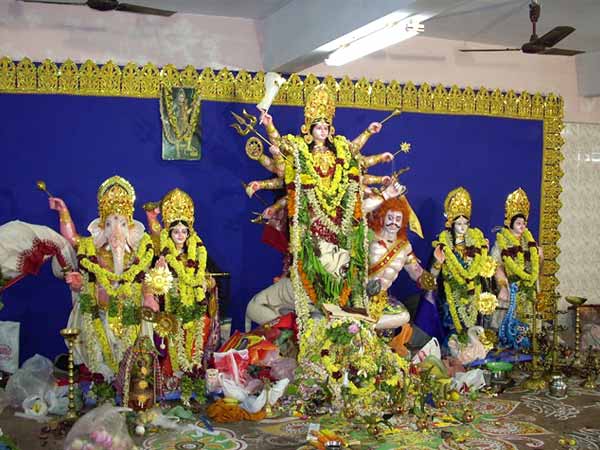
Nine Days Navaratri Celebrations
Navaratri is separated into sets of three days i.e. into three sets. These sets are made in order to adore different facets of the supreme goddess. On the initial three days, the Goddess is invoked as the supreme powerful force called Durga. Goddess Durga is meant to all our contaminations, evils and defects. On the next three days, she is worshipped as the mother of spiritual wealth, Goddess Lakshmi, She is the one who is considered to have the power of showering on her devotees with the blessings of never-ending wealth. In the final set of three days, the Goddess is worshipped as the goddess of wisdom, Saraswati. The one is responsible for spiritual enlightenment and overall success in life.
She is also worshipped under nine different names for the nine days in Navratri. Every day, she assumes a new character, a new look and a new duty. She is worshipped as Shailputri, Brahmacharini, Chandraghanta, Kushmanda, Skanda Mata, Katyayani, Kalratri, Maha Gauri and Siddhidatri. For the initial six the Pooja celebrations are limited to home. The celebrations acquire a festive form since the seventh day when the festivities of Navratri surround the atmosphere.
First Day Pooja
The first form of Goddess Durga is called Shailputri . She is considered the daughter of the Himalayas. She is a form of Shakti, the consort of Lord Shiva.
Second Day Pooja
The second form of Goddess Durga is known as 'Brahmacharini'. Her name is derivative of the word 'Brahma', which means 'Tapa' or penace. She is also a form of Uma or Parvati, a form of Mata Shakti.
Third Day Pooja
On the third day the goddess is worshipped as Chandraghanta. She is the symbolic representation of beauty and bravery.
Fourth Day Pooja
Kushmanda, is the form of the goddess which is worshipped on the fourth day. It is believed that Kushmanda is the creator of the entire Universe and she has created the entire Universe by her laugh.
Fifth Day Pooja
On the fifth day, the form of Goddess is called Skand Mata. She is actually called so because she is here represented as the mother of Skanda, the chief warrior of the Gods army.
Sixth Day Pooja
On the sixth day, the goddess is worshipped as Katyayani. Seated on her vehicle lion, Katyayani has three eyes and four hands.
Seventh Day Pooja
On the seventh day, the Goddess is worshipped as 'Kalratri'. As the name suggests, Kalrati is as black as a dark night. She has four hands, she is meant to make the devotees fearless.
Eighth Day Pooja
On the eight day, the Mata Rani is worshipped as 'Maha Gauri'. She is considered to extremely beautiful, white like snow and accessorized with white colored ornaments. She represents calmness and exhibits wisdom.
Ninth Day Pooja
On the ninth day, Durga is worshipped as Siddhidatri. It is believed she consists of all the eight siddhis. She lives on lotus and is worshipped by all the Rishis-Munis, Siddhas, Sadhakas and Yogis.

Navaratri Celebrations

|
Navaratri Celebrations
Bengal
During Navratri, Bengalis in India worship huge idols of the Goddess, perform devotional songs and dances and finally take out grand processions on the tenth day, when the idols are immersed in water. The last four days of the festival are most important for them. People worship pre-pubescent young girls, known as 'kanyas', as the embodiments of Goddess Durga. 'Ayudha Puja' is performed on the ninth day, where one worships the tools, implements of their livelihood and places it on the altar of the Goddess for her blessings of success and prosperity. Even children place their study books and writing tools on the altar and the families spend whole day in contemplation of the Goddess. On the tenth day of Dussehra, devotees perform 'Saraswati Puja' for blessings of knowledge and mental peace. During Navratri, thousands of devotees visit Dakshineswar Kali Temple in Kolkota, West Bengal.
Gujarat
In Gujarat, Navratri is a community event, where people perform devotional songs and dances that are popular by the names of 'Dandiya Raas' and 'Garba Raas', and observe Jaagran (waking through the night), to please the Goddess. Amba Mata Temple at Junagarh, Gujarat, is a favorite pilgrim for devotees, during Navratri. Here, painted earthen pots are used to represent the Goddess and Garba dances are performed by the Gujarati women around those pots, in circles. The pots are valued as the abode of the Goddess. The Rasa has its origin in the life scenes of Lord Krishna and is associated with the agricultural rites, while Garba is performed only by men and is related with the agricultural fertility.
Maharashtra
In Maharashtra, Goddess Durga is worshipped continuously for nine days of Navratri. On the tenth day, Goddess Saraswati is worshipped and on this day, school-going children worship the tantrik symbol of the goddess for her blessing in their studies. This day is also considered auspicious to begin any new thing or to buy new ornaments. Puja is performed on each day of Navratri and devotees offer the flower garland to the idol or image of the goddess Durga. In Mumbai, people visit various temples including the Ayyappa Temple at Goregaon.
Kashmir
In Kashmir, Hindu minorities of Kashmiri Pandits celebrate Navratri. People generally observe fast for nine days and stay on water and fruits or eat the food specifically made for the fast, only in the evening. They usually visit the temple of their guardian goddess Kheer Bhawani, on all nine days of Navratri. Aarti is held on the last day of Navratri at the temple and it is only after which, people break their fast. Many devotees also go to the mountain cave of the Vaishno Devi Temple, during Navratri.
Kerala
In Kerala, there is a tradition of beginning of formal education for every child aged 3-5 years on the auspicious occasion of Durga Puja. On Ashtami, according to the custom, tools are not used and are worshiped on this day. Goddess Saraswati is honored by worshiping the books and records at home, on Navami. Thousands of devotees visit Saraswati temple at Kottayam, during Navratri, to take a dip in the mysterious holy pond. People also visit the famous temples at Thekkegram (Palghat).
Mysore, Tamil Nadu, Karnataka & Andhra Pradesh
In Mysore, Chamundi, the royal deity of the Mysore royalty is worshipped during Navratri, with pomp and pageantry. There is a magnificent procession of elephants, horses, chariots and costumed attendants on the tenth day, when Maharaja goes to worship the hilltop temple of the goddess. In Tamil Nadu, Karnataka and Andhra Pradesh, women arrange 'Bommai Kolu', a special placing of dolls decorated with flowers and ornaments on specially prepared steps. Nine young 'kanyas' or virgins are offered new clothes and sweets. The married women share flowers, kumkum and snacks among themselves. Thus, Navratri is celebrated in almost every region of India, with little difference.










































